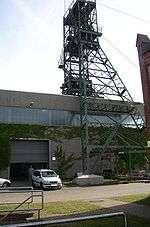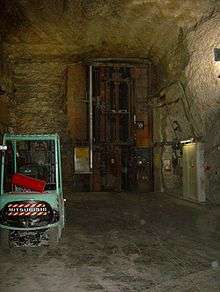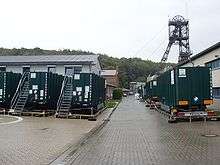Asse II mine
The Asse II mine (Schacht Asse II) is a former salt mine used as a deep geological repository for radioactive waste in the Asse Mountains of Wolfenbüttel, Lower Saxony, Germany.

History
The Asse II mine was developed between 1906 and 1908 to a depth of 765 metres (2,510 ft). Initially extracting potash, the mine also produced rock salt from 1916 to 1964. Potash production ceased in 1925.[1]
Between 1965 and 1995, the state-owned Helmholtz Zentrum München used the mine on behalf of the Federal Ministry of Research to test the handling and storage of radioactive waste in a repository. Between 1967 and 1978 low-level and intermediate-level radioactive waste were emplaced in 13 chambers in the Asse II mine. Two chambers are located in the middle part and ten in the southern flank of the mine at depths from 725 to 750 metres (2,379 to 2,461 ft) below surface. Between 1972 and 1977, exclusively medium-level radioactive waste was emplaced in a chamber on the 511 metres (1,677 ft) level.[2] Research was stopped in 1995; between 1995 and 2004 cavities were filled with salt. After media reports in 2008[3][4] about brine contaminated with radioactive caesium-137, plutonium and strontium, politicians accused the operator, Helmholtz Zentrum München – German Research Center for Environmental Health, of not having informed the inspecting authorities. On 8 September 2008, the responsible ministers of Lower Saxony and the German government replaced the operator with Bundesamt für Strahlenschutz (BFS) - the Federal Office for Radiation Protection.[5][6]
In April 2017, operator responsibility for Asse II was transferred from BFS to the Supervisory Board of the Bundes-Gesellschaft für Endlagerung mbH (BGE), under the Federal Ministry for the Environment, Nature Conservation and Nuclear Safety.[7][8]
Instability of the mine

Typically salt mining is structurally unsupported. Stresses produced in the remaining salt structure during construction of the mine voids are accommodated in the overlying rock. Plasticity effects are taken into account as they occur naturally in salt domes. Significant mechanical stress is built up between the surrounding diapir and the mine construction. The overlying rock mass in Asse II moves 15 centimetres (5.9 in) per year, undermining the strength of the mine construction.
Because of the large number of tunnels and chambers, and the decades of use, deformation in Asse II has reached a state where the pressurised surrounding salt is losing its stability: "The supporting construction is softening by creep deformation, plasticity effects and local fractures from ground pressure."[9]
In 1979 a report on the stability of the mine was released by a working group under HH Juergens,[10] which describes an imminent scenario of uncontrolled plastic flow from the surrounding rock on the southern flank resulting in the subsequent loss of the load carrying capacity. The manager of Asse II in 1979 and his advisers categorised this report as "unscientific" and declared that there were no stability problems.
In 2007 the Institut für Gebirgsmechanik (IfG) in Leipzig, which had been monitoring Asse II since 1996, predicted that an increase in the rate of loss of load carrying capacity would result in an increased displacement of the surrounding rock. The shifts would lead to an uncontrollable increase in water inflow and make continued dry operation impossible.[11]
Water inflow

A significant inflow of water and a subtle loss of mechanical stability may jeopardise the underground mine integrity – the site is in danger of collapsing and becoming flooded.[12]
For the period 1906 to 1988, when Asse II was an operational salt mine, there were 29 documented water breaches.[13] They were sometimes successfully sealed off, partly dry or sometimes with negligible inflows (less than 0.5 cubic metres (130 US gal) per day).[14]
Between 1988 and 2008 32 new entry points were recorded. In 1996, the BFS notified the Bundesumweltministerium that there was a risk of severe radioactive contamination if the mine ran full of water and that further investigation was urgently required.[15]
Most of the brine influx is concluded as coming from the diapir in the southern part of the mine. The brine is captured before it comes in contact with the storage drums, at the 658, 725 and 750 metres (2,159, 2,379 and 2,461 ft) levels and, since 2005, at the 950 metres (3,120 ft) level.[16][17] The 2008 influx was 11.8 m3 (3,100 US gal) per day.[18] The liquid is tested for the radionuclide caesium-137. All measured values have been below the detection limit. The liquid is also tested for tritium. The weighted mean concentration is about 100 Bq/litre, which is the value that must be present in accordance with the European drinking water standard. The brine is pumped into a tanker and transported to the abandoned K+S AG mines (Bad Salzdetfurth, Adolfsglück and Mariaglück)[19][20][21] The brine in Mariaglück is also tested for caesium-137 and tritium.[22][23]
Inventory
Asse II is licensed for the storage of intermediate radioactive waste (LILW-LL, Long lived) and low level waste (LILW-SL, Short lived), defined as waste without significant heat generation. After public speculation about the presence of radioactive high level waste in the mine all material was once again reviewed in August 2008:[24]
- 125,787 drums of low level radioactive waste stored from 1967 to 1978 in various chambers at the 750-metre (2,460 ft) level. The containers are mostly drums with volumes from 100 to 400 litres (26 to 106 US gal) or concrete vessels. The declared total activity at the time of storage was 1.8·1015 Bq. Around 50% of the containers came from the former Forschungszentrum Karlsruhe nuclear reprocessing plant, 20% from nuclear power plants and 10% from the former Jülich Research Centre. The containers typically included mixed and laboratory waste, rubble, scrap, filter residues and combustion residues. Liquids such as evaporator concentrates, sludges, oils, resins and solvents had to be bound as solids. According to some former employees barrels of liquid waste were accepted in the early days of storage.[25]
- 1,293 containers with medium-level radioactive waste stored from 1972 to 1977 in Chamber 8a at the 511-metre (1,677 ft) level. Only 200-litre (53 US gal) roll drums were permitted with waste fixed in concrete or bitumen. The declared total activity at the time of storage was 2.8·1015 Bq. About 97% of the packages (over 90% of the total activity inventory of Asse II) originated from the Karlsruhe reprocessing plant. Some of the Karlsruhe drums contained waste from the reprocessing plant itself, and thus fissile material. Storage limits per drum were 200 grams (7.1 oz) U-235, 15 grams (0.53 oz) U-233 and 15 grams (0.53 oz) Pu-239. These limits were not reached. Maximum values per drum were 24 grams (0.85 oz) U-235, 5.7 grams (0.20 oz) Pu-239 and less than 1 gram (0.035 oz) U-233 on the 511-metre (1,677 ft) level.[26]
See also
References
- Herrmann, Albert Günter; Röthemeyer, Helmut (2013). Langfristig sichere Deponien: Situation, Grundlagen, Realisierung. Berlin: Springer-Verlag. p. 355. ISBN 9783642588822. Retrieved 30 September 2015.
- "Radioactive waste in Asse mine". Asse II. Bundesamt für Strahlenschutz. Retrieved 2 October 2015.
- German Leaks Raise More Nuclear Fears Archived 2008-10-22 at the Wayback Machine
- Problems at Germany's Asse II Nuclear Waste Repository Archived 2009-08-03 at the Wayback Machine
- Shaft ASSE II
- Fröhlingsdorf, Michael; Ludwig, Udo; Weinzierl, Alfred (21 February 2013). "Abyss of Uncertainty: Germany's Homemade Nuclear Waste Disaster". Spiegel Online. Hamburg: Der Spiegel. Retrieved 30 September 2015.
- "Supervisory Board of the Bundes-Gesellschaft für Endlagerung mbH (BGE)". Federal Ministry for the Environment, Nature Conservation and Nuclear Safety. Berlin, Germany. October 2018. Retrieved 4 April 2020.
- "German agencies to collaborate on repositories". World Nuclear News. London, UK: World Nuclear Association. 24 August 2018. Retrieved 4 April 2020.
- Dreidimensionale gebirgsmechanische Modellrechnungen zur Standsicherheitsanalyse des Bergwerkes Asse Archived 2011-07-19 at the Wayback Machine. Institut für Gebirgsmechanik GmbH, Leipzig, 2006.
- Hans-Helge Jürgens, Katrin Hille: Atommülldeponie Salzbergwerk Asse II - Gefährdung der Biosphäre durch mangelnde Standsicherheit und das Ersaufen des Grubengebäudes, Braunschweiger Arbeitskreis gegen Atomenergie, 2. Auflage, März 1979
- Gebirgsmechanische Zustandsanalyse des Tragsystems der Schachtanlage Asse II – Kurzbericht Archived 2009-06-17 at the Wayback Machine. Institut für Gebirgsmechanik GmbH, Leipzig, 2007.
- "What now for the Asse II repository?". Institut für angewandte Technologie. Darmstadt, Germany: Oeko-Institut e.V. 2015. Archived from the original on 2 October 2015. Retrieved 30 September 2015.
- Warren, John Keith (16 December 2016). "Salt usually seals, but sometimes leaks: Implications for mine and cavern stabilities in the short and long term" (PDF). Earth-Science Reviews. Elsevier. 165: 337. Bibcode:2017ESRv..165..302W. doi:10.1016/j.earscirev.2016.11.008. ISSN 0012-8252. Retrieved 22 May 2018.
- Kaul, Alexander (29 February 1996). "Schachtanlage Asse II" (PDF). Greenpeace (in German). Bundesamt für Strahlenschutz. Retrieved 22 May 2018.
- Letter of the Bundesamt für Strahlenschutz to the Bundesministerium für Umwelt, Naturschutz und Reaktorsicherheit (29.02.1996)
- Fröhlingsdorf, Michael; Ludwig, Udo; Weinzierl, Alfred (21 February 2013). "Abyss of Uncertainty: Germany's Homemade Nuclear Waste Disaster - Part 2: Mountains of Red Tape". Spiegel OnLine. Hamburg: Der Spiegel. Retrieved 30 September 2015.
- Die Asse Chronik
- Statusbericht des Niedersächsischen Ministeriums für Umwelt und Klimaschutz über die Schachtanlage Asse II Archived December 30, 2008, at the Wayback Machine, Seite 12. Niedersächsisches Ministerium für Umwelt und Klimaschutz, Hannover, 2008.
- "Zutritt und Verbleib der Salzlösung aus dem Deckgebirge (German)". Archived from the original on 2011-07-18. Retrieved 2009-03-04.
- Hildesheimer Allgemeine Zeitung vom 16. August 2008, S. 17.
- Halbjahresbericht über den Stand der BMBF-Stilllegungsprojekte und der vom BMBF geförderten FuE-Arbeiten zu „Stilllegung/Rückbau kerntechnischer Anlagen“. Forschungszentrum Karlsruhe, 2007.
- Mariaglück Testresults
- Fröhlingsdorf, Michael; Ludwig, Udo; Weinzierl, Alfred (21 February 2013). "Abyss of Uncertainty: Germany's Homemade Nuclear Waste Disaster - Part 3: Political Foot-Dragging". Spiegel OnLine. Hamburg: Der Spiegel. Retrieved 30 September 2015.
- Statusbericht des Niedersächsischen Ministeriums für Umwelt und Klimaschutz über die Schachtanlage Asse II Archived December 30, 2008, at the Wayback Machine, Seiten 93–128. Niedersächsisches Ministerium für Umwelt und Klimaschutz, Hannover, 2008.
- Schachtanlage Asse – Befragung früherer Mitarbeiter Archived September 12, 2008, at the Wayback Machine. Helmholtz Zentrum München, 2008.
- Die Asse Chronik – Vom Umgang mit Atommüll in Niedersachsen. Fraktion von Bündnis 90/Die Grünen im Niedersächsischen Landtag, 2008.